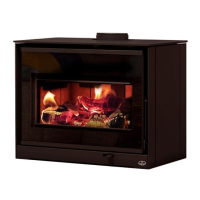Page 37
Installation and Operation Manual - Inspire 2000
9.4.2 Why the Chimney Should Penetrate the Highest Heated Space
When it is cold outside, the warm air in the house is buoyant so it tends to rise. This creates
a slight pressure difference in the house. Called ‘stack effect’, it produces a slightly negative
pressure in the lower part of the house (compared to the outside) and a slightly positive pressure
zone in the high part of the house. If there is no fire burning in a heater connected to a chimney
that is shorter than the warm space inside the house, the slight negative pressure in the lower
part of the house will compete against the desired upward flow in the chimney. This occurs for
the two following reasons:
First, the chimney runs up the outside of
the house, so the air in it is colder and
denser than the warm air in the house.
And second, the chimney is shorter than
the heated space of the house, meaning
the negative pressure in the lower part
of the house will draw cold air down the
chimney, through the wood fire and into
the room. Even the finest wood fire will
not work well when connected to this
chimney.
9.5 Installing the Flue Connector
The flue has been called ‘the weak link’ in the safety of wood heating systems because failure to
install the flue connector properly (which has been common in the past) can result in house fires.
The best flue is one that rises straight up from the wood fire to the base of the flue system
with no elbows. Straight assemblies are less likely to cause problems like smoke roll-out when
the door is open for loading. They are also more stable and easier to maintain than assemblies
with elbows. Horizontal runs of flue should be avoided where possible because they reduce flue
system draft.
Figure 35: Best Figure 36: Acceptable Figure 37: Avoid

